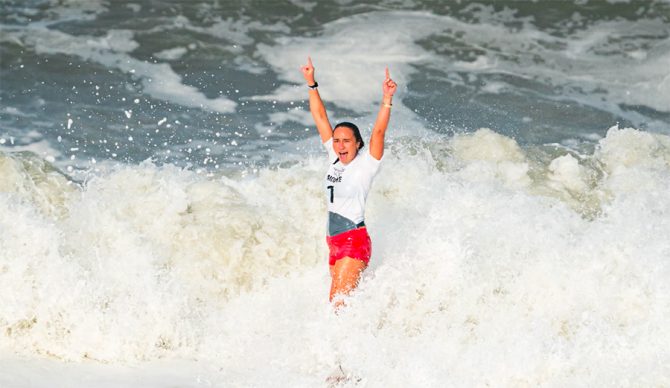
Carissa Moore will be seeded differently this time around. Photo: ISA
The 2024 Paris Olympics will use a new technique to seed surfers. Having flown rather under the radar, the ranking from the 2024 World Surfing Games (WSG) will determine the Olympic seeding order for the competition at Teahupo’o. For those surfers who did not compete in the WSG, they’ll receive the lower seeds according to the qualification system hierarchy.
A statement on the ISA’s website reads as such: “The Paris 2024 pre-competition seeding process will seed all Olympic qualified athletes from their individual result at the ISA World Surfing Games 2024 based on who is eligible for the Olympics and in attendance at WSG 2024.”
It’s a rule change that could have major implications for the Olympic medalists. Surfers who qualified via the WSL CT who performed poorly at, or missed, the 2024 WSGs, will now have to tee off against the top seeds right off the bat, or early in the bracket.
For example, the top finishing Olympians at the 2024 WSG, Gabriel Medina and Tatiana Weston-Webb, will have the top seeds at Paris 2024. For Tokyo 2020, the seeding order simply used the qualification system hierarchy. That is, the CT surfers were awarded the top seeds according to their ranking on the CT. Those who qualified via the WSG and Pan American Games, were given the lower seeds. That’s now been turned on its head.
CT surfers who performed poorly at the WSG now might have to face the top seeded Medina and Weston-Webb early in the competition. It’s particularly disadvantageous for surfers like Filipe Toledo who finished 16th, Kanoa Igarashi who finished 64th, and Joao Chianca and Griffin Colapinto, who weren’t able to compete. And for the women, surfer’s like Caroline Marks, who, with the old system, would have been the top seed, is now the nine seed based on her WSG result. And Tyler Wright, who would have been the three seed, finished 29th and was sent tumbling down the seeding order as well.
On the other hand, surfers who performed well and qualified at the WSG will be handsomely rewarded with high seeds. For the men, surfers like Ramzi Boukhiam, Kauli Vaast, and Joan Duru, and for the women, Nadia Erostarbe, Sol Aguirre, and Anat Lelior, for example.
The reason for the change was presumably to allow the surfers to earn their seeding order against (nearly) all the Olympic competitors. It’s the ultimate form of meritocracy, is it not?
Critics will say that seeding for an event at Teahupo’o should not be decided in the conditions that were experienced at the WSG in Puerto Rico, which varied from overhead tubes to onshore wind-whipped junk. But, whether you like it or not, that’s how it is. There is something rather egalitarian about how the surfers were pitted against each other to determine the Olympic seeding.
Ultimately, I reckon that the outcome of the event will be affected by this seeding rule change. I look at a surfer like Kauli Vaast, the Teahupo’o local and expert, who is now the three seed, and I can’t help but ponder his chances to win gold. He’ll have a relatively easier runway to warm up in his early heats to ultimately tee off against the favorites, Gabriel Medina and John John Florence.
There hasn’t been much talk about the Olympic seeding. Actually, there’s been so little chatter that I wonder if all the surfers were aware of what was on the line when they were competing at the WSG. They’ll be eagerly awaiting the heat draws, and there most certainly will be some awkward match ups and early upsets due to this system.

